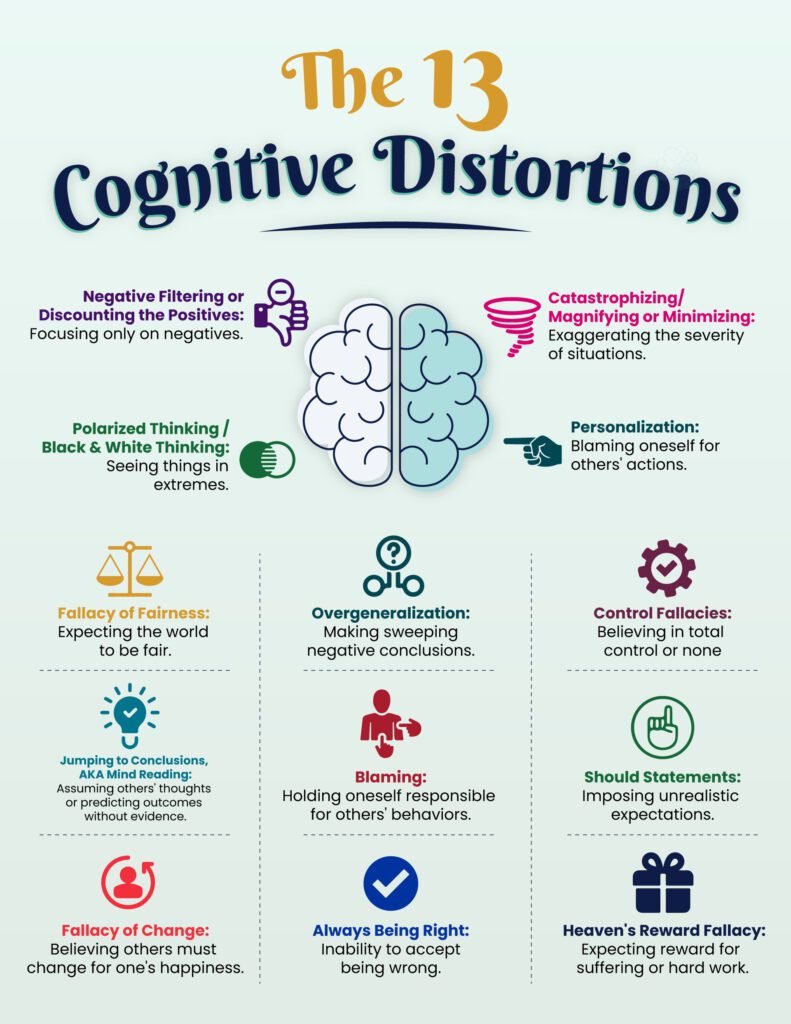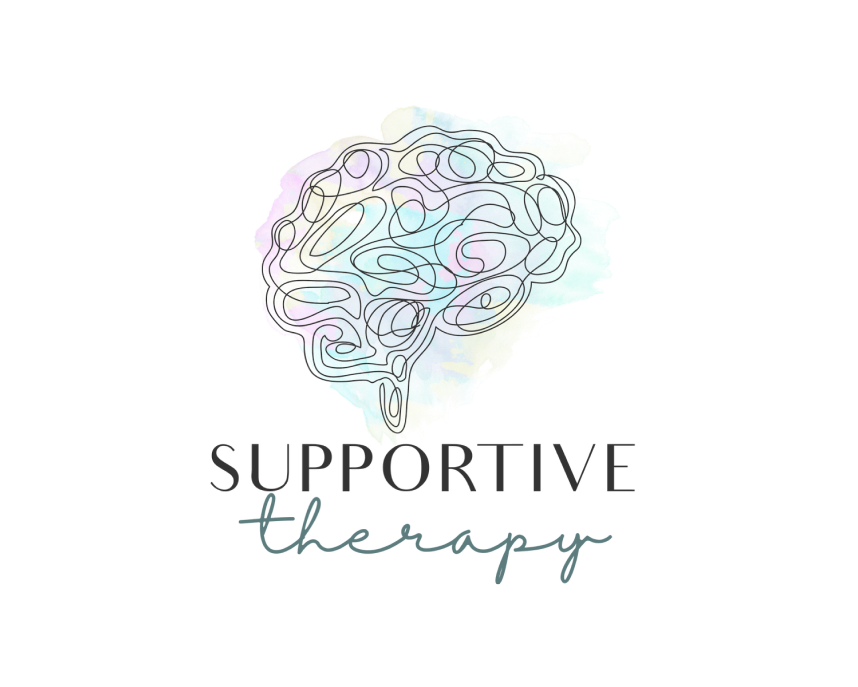Home » The Complete Guide to CBT » Cognitive Restructuring
Change Negative Thought Patterns with Cognitive Restructuring
Learn how cognitive restructuring enables individuals to reshape harmful thought patterns into hopeful beliefs about themselves and the world around them.

What is Cognitive Restructuring?
Negative thoughts are something everyone deals with. At times, we all have an overly critical inner voice or prematurely label situations or people as hopeless. Such thoughts are generally harmless if they don’t significantly affect our daily lives and can be brushed off or challenged in the moment. However, if negative thoughts persist unchecked, they can develop into cognitive distortions.
Cognitive distortions are persistent, irrational thought patterns that negatively influence how someone perceives themselves and the world around them. These distortions warp reality, harming mental wellbeing, and are associated with various mental health issues.
Cognitive restructuring—a core component of Cognitive Behavioural Therapy (CBT)—is the practice of identifying and challenging these damaging cognitive distortions to foster healthier ways of thinking.
How Does Cognitive Restructuring Work?
The process of cognitive restructuring is a gradual and intentional shift. In a therapy setting, a counselor first helps their client spot thought patterns that are causing self-harm, then they challenge those thoughts to see if they’re true. This is followed up by gently guiding the client to replace their cognitive distortions with a more balanced perspective, and reinforced through continued therapy.
A few examples of common cognitive distortions are:
All-or-Nothing Thinking: where people or situations are viewed as entirely good, or entirely bad, with no in-between.
Catastrophizing: when negative outcomes are consistently exaggerated to the point of being catastrophes.
Personalization: where individuals feel personally responsible for things outside of their control.
Emotional Reasoning: When one’s view of reality is shaped by feelings over tangible facts.
Cognitive restructuring tackles these distortions and many more by examining the evidence for them and comparing it against a more truthful interpretation of reality.

Dispute and Replace Your Negative Thoughts
Discovering and challenging unhelpful thoughts in cognitive restructuring can take many forms, but one consistent theme is called “Socratic questioning”. It consists of clarifying thoughts, exploring assumptions and evidence, and then testing alternative perspectives in a logical way.
Socratic questions may look something like this:
- What am I actually worried about?
- Are my thoughts on this situation accurate?
- What factual evidence do I have to support my view?
- Am I viewing this situation in black and white when it’s more complicated?
- Am I basing my thoughts on facts or feelings?
- What’s the worst thing that can happen if my view of this situation is correct?
- Are there any positive actions I can take to influence this situation?
The next step after a cognitive distortion has been uncovered is ameliorating it with a better replacement thought. This part of the process is called “cognitive reframing”. It’s important to note that the goal isn’t necessarily to force a more “positive” thought but rather to create a less distorted and more objective view.
There’s no set system for reframing, so it looks different for each scenario. However, it generally coaxes the individual to focus on the hopeful aspects of any situation and the agency they possess.
Best Practices and Techniques
CBT counsellors are well-versed in various cognitive reframing techniques since each unique client needs a different approach. Some cognitive reframing techniques can even be practiced alone as a general mental health exercise to improve overall thinking habits.
Increasing Thought Awareness
This CBT tactic refers to catching automatic negative thoughts (ANTs), and making them conscious. Negative thoughts tend to pop up without notice, and the first clue is most often a negative feeling like anxiety. That feeling can then be traced back to whatever thought caused the negative shift in emotional state.
Life Event Visualization
Cognitive reframing sometimes requires clients to change how they view events from their past, and this concept is called “life event visualization”. This strategy always focuses on a significant life event that brings up strong negative emotions. A counselor will gently explore alongside the client to discover why the event holds such weight, and any negative beliefs that may have stemmed from it.
Thought Records
Thought records are an at-home cognitive reframing tool that tracks cognitive distortions as they come up. They typically follow a worksheet-like structure that helps to identify key information such as emotions, the situation, and negative thoughts. This data can be used in therapy sessions or for self-analysis.
Decatastrophizing
This technique specifically tackles the “catastrophizing” type of cognitive distortion, although it’s a healthy mental habit for anyone to have. It works by identifying a catastrophic thought and deflating it into a realistic view of outcomes.
Mindfulness
Mindfulness is a broad tool used across many types of therapy, and it can be a particularly helpful addition to other cognitive reframing tactics. It allows individuals to reach a less heightened emotional state to more accurately assess their thoughts.
Reframing Thoughts
This practice makes up the backbone of cognitive reframing. It refers to the process of shifting negative or distorted thoughts into less harmful ones through continual repetition, often with the help of a counsellor.
Thought Journaling
Thought journaling can be similar to thought records, but they’re less structured and have more variety. Free form thought journaling can be helpful as well as personal reflections or prompt-based writing.
Behavioural Activation
Behavioural activation works backwards from many of the other cognitive reframing techniques. It focuses on changing behaviours first in order to cause positive emotional shifts that help to change thoughts.
Mental Health Conditions Most Effective for Cognitive Restructuring
Cognitive restructuring can be beneficial for anyone, but it’s an especially vital tool in treating these mental health issues.
Anxiety is one of the mental health concerns where cognitive restructuring shines the brightest. Anxiety disorders can develop in response to distortions that produce fear, so addressing thoughts directly can essentially treat the root cause in these cases.
Eating disorders also tend to arise from disordered thinking, more specifically around body image, control, and food. Cognitive reframing can ease obsessions and impossible expectations around food by creating a healthier relationship to one’s own body.
Cognitive reframing can likewise be pivotal in treating depression. Negative ways of thinking are sometimes the culprit behind depression when they lead to low self-esteem, hopelessness, and constant pessimism.
PTSD is another condition where counselling can be immensely helpful, and cognitive reframing can play an especially key role. Reshaping how a client views their trauma can be freeing, and there’s often a need to address harmful distortions that have grown in response to the trauma.
Substance Abuse is almost always a more complex issue than public perception understands it to be. Cognitive distortions can both cause and reinforce substance abuse habits, and cognitive reframing is a much-needed component in most forms of treatment.
Finally, cognitive reframing can help resolve marital problems for many couples by repairing distorted thinking about one another. Cognitive framing helps each party see their partner more clearly without harmful and hurtful assumptions.
The Benefits of Dedicated Cognitive Restructuring
The benefits of consistent and effective cognitive restructuring are virtually limitless. This ongoing practice of shifting thoughts toward healthier perspectives can enhance self-esteem, improve emotional regulation, and significantly reduce stress.
Cognitive restructuring can also foster self-growth by increasing self-awareness and creating a hopeful growth-oriented mindset. This empowers individuals to take control of their lives and pursue their purpose with less hesitation.
It’s also very likely to see relational benefits as a result of cognitive restructuring work. Having a clear view of oneself and others creates a harmonious foundation for any type of relationship, and the added bonus of better emotional regulation from cognitive restructuring makes it easier to navigate conflict.
Drawbacks of Cognitive Restructuring
While cognitive restructuring is a powerful tool, it’s not effective in every scenario.
For instance, cognitive restructuring isn’t beneficial when individuals already hold an accurate perception of themselves and their lives. In such cases, negative emotions may exist without cognitive distortions being present.
Additionally, cognitive restructuring requires a certain level of self-awareness and accountability. Individuals who significantly lack insight or struggle with self-reflection may find it challenging or ineffective to recognize and address their cognitive distortions.
Finally, cognitive restructuring might not be suitable in trauma-related situations. Trauma often leaves lasting emotional and physical imprints that persist even when individuals logically understand they’re no longer in the traumatic environment. In these cases, alternative therapeutic approaches may be necessary.
Schedule a Free Consultation
Begin the life-changing process of changing your negative thoughts. Schedule a free online consultation with one of our specialized CBT counsellors.
Frequently Asked Questions
The three c’s of cognitive restructuring are to “catch it, check it, change it”. Catching distortions as they arise takes self-awareness, checking them takes practice, and changing them is the last step where all the benefits begin to take hold.
Since dialectical behavioural therapy (DBT) is catered towards individuals who struggle with emotional regulation, its cognitive restructuring component is balanced with emotional validation and mindfulness. It’s overall a gentler approach to thought reframing that focuses less heavily on reasoning.
One common cognitive distortion is believing that one will never find a relationship due to low self-worth. Reframing this belief to understand one’s own inherent value and special qualities can instill more patience and combat feelings of hopelessness. That is an example of cognitive restructuring.
The key to reframing intrusive thoughts is to question their validity. This can be done by looking for evidence to support them and then examining what a more realistic perspective would look like. This can help to dismiss intrusive thoughts in a non-judgmental and emotionally unattached way.

